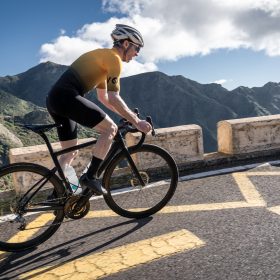Last week we introduced you to the basic concepts of training for cycling. In the second part of our little encyclopedia, we go into depth and we will explain what NP, TSS or sweet spot mean. Many of these terms help you to understand your own training and provide a brief insight into sports science and the work of professional trainers.
The 101 of training for cycling – Part II
Aerobic
In the aerobic zone, the energy required for cycling is produced from oxygen, fat and glucose. Training in the aerobic zone is especially important for your endurance.
Anaerobic
In the anaerobic zone, energy is supplied very quickly, but without using additional oxygen. Lactate is produced as a by-product. Anaerobic metabolism takes place at high intensities.
Anaerobic capacity
Anaerobic capacity describes the maximum work a body can do in anaerobic metabolism. It can be trained at short and very intense intervals of 30s to 3min. This training zone is equivalent to 121-150% of your FTP.
Cool down
At the end of each workout, the body should be “cooled down”. 15-20min at max. 56-75% of your FTP help to support the regeneration and prevent injuries.
FTP test
In a performance test, the goal is to find out your individual FTP. This can be done by experienced coaches or sports scientists or you can test yourself with the so-called 20-minute test. The FTP is the basis for training in cycling with a power meter.
HIIT
High-Intensity Interval Training – a modern form of training in which training effectiveness is increased by using short and high intense training loads, coupled with short recovery periods. An example is the Tabata workout, overall this workout is only 4 minutes long. 8x 20s “All out” and 10s break. All in all, HIIT is not yet widely used in cycling training; it has only been used increasingly in recent years.
IF – intensity factor
The intensity factor of a training session compares the normalized performance with the FTP of a rider and indicates how intense the workout was.
Lactate threshold
At this treshold more lactate is produced in the muscle than can be removed by the body. Consequently, the lactate level in the body increases. The lactate threshold is also the training zone at 91-105% of your FTP.
Neuromuscular Power
The maximum power, the all-out. This performance level is achieved during the sprint at over 151% of your FTP. It can only be held for a maximum of about 10 seconds.
Normalized Power
The normalized power (NP), in contrast to the average power, also includes the total stress for the whole body. When you ride the first hour at exactly 100watts and the second hour at 300watts your average power would be 200watts. However, the NP of this workout is above 200 watts, since the effort to ride at 300 watts is significantly higher. Thus, the NP provides a much more accurate statement about the intensity of the entire workout.
Regeneration
There is a German proverb: “In der Pause wächst der Muskel.” – “During the break, the muscle grows” – The regeneration after a workout is as important as the workout itself. After a workout, the body needs time to recover and to be able to process the previously set training stimulus. In addition, the “active regeneration” is also a training zone below 68% of your FTP. Those workouts are at very slow pace to give the body the opportunity to recover from a previous hard workout.
Sweet Spot
The “sweet spot” is about 88-94% of your FTP, just between the training zones “Tempo” and “Lactate Threshold”. It covers a wide range of adaptations in your body. Therefore, it is an ideal complement to endurance training at the beginning of the cycling and helps to improve your FTP.
Tempo
Training zone below the FTP but with higher intensity than pure endurance training. Typical training zone for Fartleks or faster group rides at 76-90% of your FTP.
TSS (Training Stress Score)
The TSS indicates how high the stress of a training session actually was. Both the duration of the training and the intensity are considered, as well as the performance level of the athlete. A training session of exactly one hour at your FTP results in a TSS of 100. TSS therefore allows a long-term evaluation and planning of training sessions.
Watt / kg
Watts per kilogram puts a cyclist’s performance in relation to his body weight. As a rule, tall and heavy riders have a worse ratio of FTP to their body weight than climbers. Heavier riders, such as sprinters, produce higher maximum values and are able to keep up very high watts over a longer period of time. Especially on long climbs, the relationship between power and weight becomes extremely important. That’s why very small riders like Nairo Quintana of Movistar Team can climb very well.



